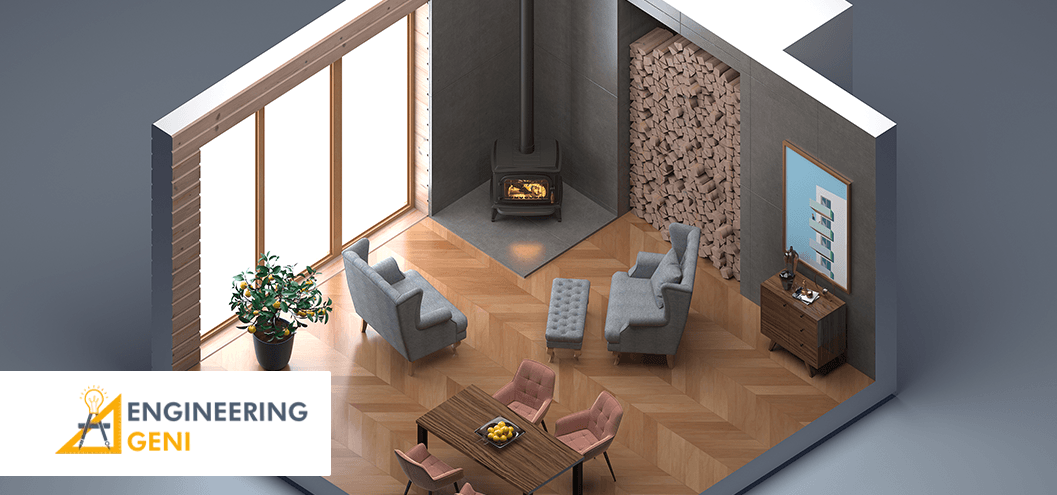What Is a 3D Color Floor Plan? Benefits, Comparison & Why You Need One Today
visualizing a space before the building begins is something much needed. Thus, a very good 3D colored floor plan does exactly that. as a colorful 3D color floor plan rendering will allow the customer, architect, and contractor to see the building with depth, texture, and liveliness, instead of 2D drawings or even flat blueprints.
Importance of 3D color floor plan rendering
Having a 3D color floor plan rendering before construction begins, takes away fuzziness in ideas about the space relating to furniture placement and lighting flow, which causes misunderstandings and misinterpretations that lead to costly mistakes. They help distinguish one space from the other, accentuate materials, and bask the viewer into appreciation. Therefore, a 3D colored floor plan will enhance your chances-whether as an agent trying to impress your clients or as someone who wants to get a design across.
Key Features of 2D Color Floor Plans
2D colored floor plans might not captivate the same way as 3D renderings, yet they are a significant and practical instrument in architecture and real estate marketing.
- Room differentiation through colors: Viewing spaces is easy, as each zone is colored differently.
- Furniture and fixture outlines: Add basic furniture to give an impression of the spatial usability.
- Simplicity: These are easy to draw as compared to 3D floor plans but still deliver their clarity.
- Printable and shareable: Such files are generally small in size and are easy to print, the best fit for brochures and listing packages.
Although 2D plans do not have the depth of 3D views, colored versions still represent an important means of getting clients to understand the overall layout and flow.
Benefits of Using 2D Color Floor Plans
Particularly for architects and real estate agents, 2D color floor plans have several benefits. Although the ultimate objective might be a full three-dimensional color floor plan, a well drafted 2D arrangement often serves as a vital first step.
- Economical and quick: Usually less expensive and quicker to produce than 3D renderings, 2D color floor plans are usually found applied during preliminary project presentations.
- Color-coded: To facilitate quick comprehension. Color coding aids customers who may not be familiar with architectural plans and streamlines navigation.
- Lightweight: lightweight and aesthetically beautiful, these are ideal for websites, social media campaigns, and brochures.
- Consistent color schemes: It helps customers to swiftly compare several floor plans or styles of a house.
While a 3D color floor plan gives very vivid detail and elements for visual interest, 2D still preserves its uses as an intuitive clarity and efficiency tool.
2D Color Floor Plan vs. 3D Floor Plan
Your project’s needs, audience, and budget will help you to choose between a 2D color floor plan and a 3D floor plan.
- Visual Depth: A 3D color floor plan provides depth, shadows, textures, and material finishes; essentially, strolling across the area.
- Time and Cost: With 2D plans, you can save time and money. On the other hand, a 3D color plan can be more time-consuming and skill-intensive but achieve far greater visual impact.
- Audience: While technical audiences such as builders and architects may tend to prefer a 2D design, 3D graphics, with their more realistic approach, evince a stronger response from the clients, investors, or homebuyers.
- Marketing Use: A 3D color floor plan will shine in websites, virtual tours, and social media promotions. Catching the eye, it contributes to emotional selling of the property.
Difference Between a Black & White Floor Plan and a Color Floor Plan:
Although the distinctions between a color floor plan and a black and white one may seem little, the influence on perception and clarity is great.
Black & White Floor Plans: Lines, markings, and grayscale symbols make up these straightforward plans. Though they are neat and professional, nontechnical persons may have trouble grasping them fast.
Color Floor Plan: Introducing color coding, room textures, and even furniture drawings turns these plans at once more interesting and user friendly. Customers better grasp the architecture and seem more linked to it.
Combining reality with architectural precision, a 3D color floor plan stretches this much more.
Step-by-Step Guide to Creating a 2D or 3D Floor Plan
Following are the steps to create a 2D or 3D color floor plan.
Step 1: Take measurements
Accurate measurements of the property must include wall placements, the location of windows, and door placements.
Step 2: Make a base layout
Draw basic floor plans with design software applications
Step 3: Add paint
Paint colors according to rooms, halls, bathrooms, and living spaces.
Step 4: Building a 3D model
In this step, wall height, furniture textures are added. A 3D layout is prepared to proceed further.
Step 5: Winding up
Check the model for correctness and make sure everything is good to go.
Step 6: Share
Image formats or interactive files suited for high quality should be used in any brochures, websites, or presentations.
Both are unique in their own contexts but a 3D color floor plan gives an everlasting impact.
CAD Drawings vs. 2D Color Floor Plans
The most important CAD drawings are made for architects and engineers. They comply with strict industry practices and provide exact measurements, symbols, and structural detail. These drawings are difficult for clients to interpret however important they are to construction.
- On the other hand, 2D color floor plans are much simplified, more visually attractive versions drawn purely so that people could easily read them. They strip away the complex details, focusing instead on layout, flow, and design intent.
- Generally; 2D color floor plans are far more effective for client presentations and marketing while they serve as quick references. CAD drawings are probably the most construction-technical work around.
A 3D color floor plan can be placed between the two because it gives clarity but keeps the building intact.
Why You Should Use a 3D Color Floor Plan
In today’s competitive design and real estate world, standing out matters. A 3D color floor plan does exactly that. It invites people into the vision. Thus, it is very important to select the best company like Engineering Geni that provide expert 2D and 3D color floor plans.
Conclusion:
More than only a design tool, a 3D color floor plan helps one to communicate, connect, and convert. Investing in expert visual representation goes a great distance whether you are selling a house, designing a remodel, or delivering a presentation to stakeholders.
Although 2D color floor plans and CAD drawings have their own value, nothing grabs attention like a fully rendered, color-rich 3D representation of your area. What you feel matters; it is not only what you see.
“Ready to bring your space to life? Contact the experts at Engineering Geni to discuss your 3D color floor plan project today.”
FAQs:
Q: Which programs would you recommend to generate 3D color floor plans?
Ans: Popular tools are recommended to generate 3D colors. One should select according to their technical capability and design demands. However it is recommended to take professional services.
Q: Are 3D color floor plans expensive?
Ans: Yes, it can be more costly than 2D plans but offer a higher return in client engagement and understanding.
Q: Can I use 3D color floor plans for marketing?
Ans: Yes, they are excellent for brochures, websites, social media, and virtual presentations.




